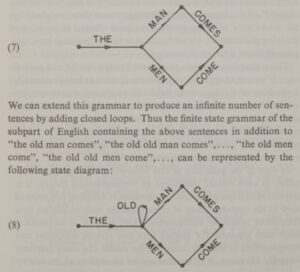 Published: ‘s-Gravenhage, Netherlands, 1957
Published: ‘s-Gravenhage, Netherlands, 1957
If a reader should take away a single sentence from this unassuming paperback publication, let it be this one:
Colorless green ideas sleep furiously.
Most of us will agree that this sentence is grammatically correct. Semantically speaking, on the other hand, it makes no sense at all. Armed with this example, Noam Chomsky undermined the prevailing linguistic models of the day, sending shockwaves through academia and altering the linguistic landscape forever.
Like Newton’s Principia and Marx’s Das Kapital, this slim volume precipitated nothing short of a revolution in its field. With Syntactic Structures, Chomsky – now an MIT  Institute Professor – took modern linguistics in a whole new direction. This, in turn, opened up new directions in psychology, philosophy, and a number of other disciplines.
Institute Professor – took modern linguistics in a whole new direction. This, in turn, opened up new directions in psychology, philosophy, and a number of other disciplines.
In the year 2000, the Center for Cognitive Science at the University of Minnesota published a list of the 20th century’s 100 most influential books in cognitive science. When the votes were counted, Syntactic Structures was at the top.



